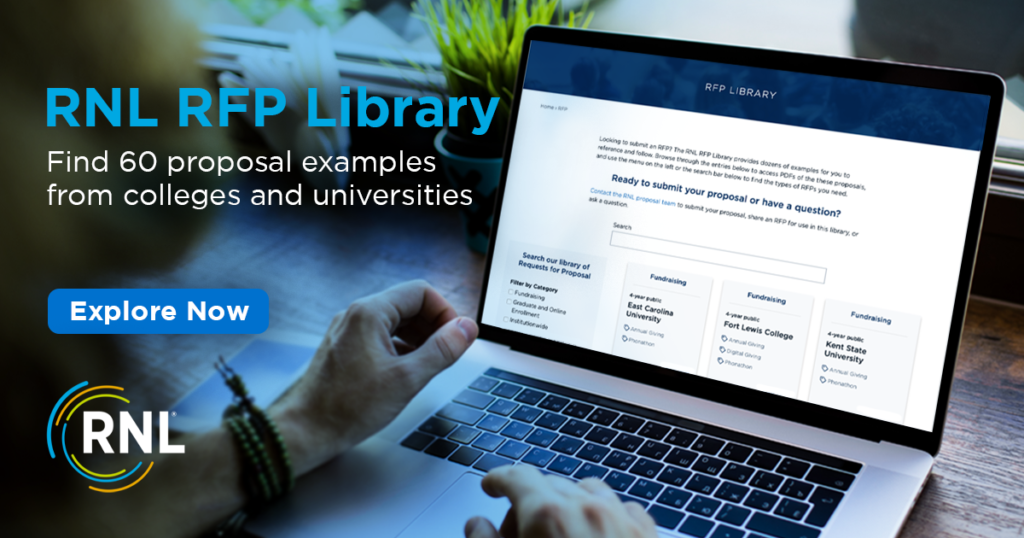enrollment
Higher Education RFPs: 5 Strategies for Getting the Right Proposal
All institutions have acquired services and products through a proposal of some kind, but in many cases, institutions may be required to set up a request for proposal (RFP) competition to create a fair basis for comparing vendors and solutions. You likely have a good idea of what you want—you’re just trying to validate that decision and/or find the best provider. Or maybe you’re unhappy with your current provider’s performance and you’re looking for a better approach.

In any case, the bidding process is often accompanied by more groans than cheers. In my time with RNL, I have never come across a campus colleague who has been excited or looking forward to the RFP process. From public universities to private colleges, the RFP process can be long and arduous—full of paperwork, forms, and yet another committee. Evaluating proposals and selecting a partner is more often the “fun” part. Writing the request in order to receive those proposals? Not so much.
Avoid creating a Frankenstein RFP
In my decade of working on higher education RFPs and their numerous counterparts (e.g., RFQs, RFIs, etc.) I’ve managed the process to prepare responses to nearly 1,000 requests. As challenging as it can be to prepare a response, I have come to realize it is perhaps more difficult to develop the RFP itself to:
- Clearly articulate your business problem.
- Establish the rules you expect all bidders to follow.
- List the requirements you need bidders to address to solve your problem.
Doing that takes a lot of time and coordination—but a lot of resources have gone into the process by this point, so institutions often feel rushed to issue their RFP.
Like any large-scale project, an RFP is often broken down into parts and written by a committee. And because no one wants to start with a blank page, many RFP creators repurpose previous ones. I call them Frankensteins, because it’s easy to tell when sections of the document were pieced together from different sources. Without careful editing, RFPs can quickly become disorganized, ask redundant questions, and have contradictory requirements. As a result, efforts to prescribe a structure to easily compare various approaches to solve a problem often leave bidders scratching their heads, wondering exactly what you need to make an informed decision.
Remember: The quality of the proposals you get is commensurate to the quality of your request, so you can’t make it too time consuming or cumbersome for bidders to decipher.
Five strategies for receiving better proposals
As former higher education practitioners, many of us at RNL have been responsible for leading or contributing to an institution’s RFP process. We’ve learned a thing or two from these experiences with higher education RFPs as well as in helping our industry colleagues navigate the unique processes in place at nearly every institution type across the country.
1. Be specific about what you want so you find the right provider
Start by describing the type of companies you’re hoping to work with on the project. For example, saying you want to work with a consulting firm isn’t very specific. Saying you want to work with a higher education consulting firm that specializes in marketing and student recruitment strategies for regional public institutions? Now that’s specific, and you will receive proposals from better-fit companies.
Take this one step further by articulating what you want in a partner. Most experience? Single source? Lowest cost? Fastest delivery? Highest-quality staff? Tell bidders what you care about so they can align their proposals with what matters most to you.
2. Focus on the big picture instead of drowning in the details
It’s important to articulate what you need in the RFP, but too much detail will lead to proposals awash in minutia of how the work will be done and may lack the strategic vision of how the proposed solution will accomplish your goals. Let the bidders describe their solution—don’t focus on how they should perform the work. There also may be numerous ways to solve the issue—encourage bidders to think outside the box and suggest solutions you may not have thought of yet.
If you’re not sure what solution might solve your particular problem, consider issuing a Request for Information (RFI) first to gather general information about potential partners and the range of solutions. This brief, more casual process casts a wide net to help you better gauge interest and scope among potential partners. You can use responses and intel gained to nail down the details and craft a more effective RFP that you can then send to a shortlist of providers.
3. Make your timeframe clear
Be up front about your timeline—both for the RFP process and the project. Mention all key dates from the release of the RFP to the partner selection process to project implementation. Give bidders the opportunity to scope comparable solutions that will be completed within an acceptable timeframe. You don’t want to spend time evaluating proposals that won’t be able to accomplish the work when you need it.
Make sure you give interested firms an opportunity to submit questions. Better yet, host a pre-proposal Q&A conference call, webinar, or meeting—but not too close to the deadline for proposals. Give bidders enough time to react to your answers and clarifications. With more information, they may need to modify their response to better align with your goals and expectations. Provide answers to all questions in the form of an RFP amendment or addendum available to all interested bidders.
4. Be transparent about your budget
Signal how serious you are about the project by disclosing information about your budget. You don’t want to waste time evaluating proposals way out of your range. It will also allow you to get more comparably scoped solutions that are easier to compare as bidders compete for what they can each offer at the same or similar price. If you don’t have a budget, consider if you’re ready to issue an RFP. Keep in mind, a budget doesn’t need to be an exact figure—it can be a range. Bidder questions, proposals, and presentations will help make it clear whether that range is appropriate and reasonable for the scope of work and the goals you want to achieve.
5. Leave time for review and proofing before you submit
Last, but certainly not least, have a third party on campus review, edit, and proof your RFP before you issue it. Check and double check your dates—make sure you’re consistent. Find someone removed from the process who can more easily identify any inconsistencies or issues that will help reduce confusion from interested bidders. And if you are interested in discussing your RFP with the RNL proposal team, please contact us.
Invest in your RFP and you’ll reap the rewards
A well-articulated RFP sets the stage for stronger proposals and more confidence in your partner selection. Higher education RFPs that address these common pitfalls will alleviate bidder frustration while showing them you are serious about the project, its success, and a partner aligned with your goals and the values of the institution.
Find 60 higher education RFPs in our library
The RNL RFP Library is a great resource if you need to create an RFP. You’ll find actual requests from campuses for undergraduate and graduate enrollment, fundraising, student success, and campuswide projects. Search for RFP examples that match your needs and make your RFP process a major success.

